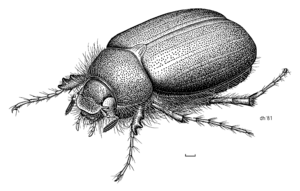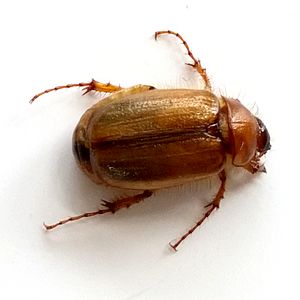New Zealand grass grub facts for kids
Quick facts for kids New Zealand Grass Grub |
|
|---|---|
 |
|
| Costelytra giveni illustration by Des Helmore | |
| Scientific classification | |
| Synonyms | |
|
Prior to 2016 mischaracterized as Costelytra zealandicus (White, 1846) |
The Costelytra giveni, often called the New Zealand grass grub, is a type of scarab beetle. It lives only in New Zealand. This beetle is a common pest in pastures, which are fields where animals like sheep and cows graze.
Contents
What is the New Zealand Grass Grub?
C. giveni was first described in 1952 by B.B. Given. However, he mistakenly identified it as another species, Costelytra zealandica. In 2016, scientists CocaAbia and RomeroSamper found differences between the two species. They then gave the grass grub its correct name, C. giveni, honoring Given.
How to Identify a Grass Grub
New Zealand grass grubs are very common insects in New Zealand. They are part of a group of insects that go through a complete metamorphosis. This means they have four life stages: egg, larva, pupa, and adult.
Adult Beetles
Adult grass grub beetles can grow up to 13 millimeters (about half an inch) long. They are shiny brown and have hard wing covers called elytra. A plate-like part called the pronotum covers their thorax. You can often see these adult beetles flying around in the evenings during summer.
Eggs
After mating, female beetles lay up to 100 eggs. They lay them in wet or loose soil, about 10 to 15 days after mating. The eggs are small, white, and oval-shaped, about 1.5 millimeters wide. After 3 to 4 days, the eggs become smooth and round. They swell up by soaking in moisture. When they are ready to hatch, the eggs turn a dark brown or black color.
Larvae (Grubs)
When they hatch, the larvae (also called grubs) are whitish-grey. They have a C-shaped body with segments. Their head is darker, and they have dark brown jaws called mandibles. They have three pairs of legs attached to the part of their body behind the head. Young larvae are about 5 millimeters long and grow up to 25 millimeters. They start weighing 2 to 3 milligrams and can grow to 200 milligrams. The most noticeable thing about a larva is its very swollen abdomen, which looks much bigger than the rest of its body. They also have many thin hairs along their sides, especially on the abdomen. Sometimes, you might find purple, yellow, or green grubs. These grubs are usually sick.
Pupae
The pupae start as a creamy white color, similar to the larvae. They slowly turn dark brown as they develop. Pupae have soft bodies and are usually shorter and thicker than the larvae. They grow to be between 10 and 30 millimeters long. They have a thin, clear skin called the epidermal layer. Through this skin, you can see their wings and legs forming.
Where Grass Grubs Live
Costelytra giveni lives all over New Zealand. However, similar species can be found in other countries. For example, the Tasmanian grass grub (Acrossidius tasmaniae) lives in Tasmania, Australia. Grass grubs prefer to live in areas below 1200 meters (about 3,900 feet) in height. They like free-draining loam soils best, but they can also be found in peaty or sandy soils.
Life Cycle of the Grass Grub
The New Zealand grass grub usually completes its life cycle in one year. However, it can take up to two years if the weather is bad, like during a drought or very cold periods. It can also take longer if the soil is too wet or if there isn't enough food.
Adult beetles live for about 4 to 6 weeks. They come out of the ground in spring (October to December) when the air temperature is above 10 degrees Celsius (50 degrees Fahrenheit). They usually fly twice. The first flight is to find a mate. The second and later flights are for feeding and laying eggs. Female beetles are the last to come out of the soil. This means they often lay their eggs close to where they emerged, leading to many grubs in one area.
Females lay groups of 5 to 80 eggs. These egg clusters are usually 80 to 250 millimeters (about 3 to 10 inches) deep in the soil. A female can lay two to three groups of eggs over a period of two to three weeks.
Costelytra giveni larvae hatch between November and March. They start eating the roots of clover and other pasture plants as soon as they hatch. They continue to feed until September. During this time, they go through three growth stages called instars before they turn into pupae.
In summer, the grubs shed their skin and reach their second instar stage. By early autumn, they are usually fully grown and in their third instar stage. This is when they cause the most damage to pastures because it's their last feeding stage before winter. In late autumn and winter, they move deeper into the soil, usually 50 to 200 millimeters (about 2 to 8 inches) down. During this time, their color changes from grayish-white to yellow or cream. Once they reach the right depth, the grub empties its stomach. It then forms a smooth, oval-shaped cell. You can see its developing wings and legs through its clear skin as it changes into a pupa. This process takes about 30 to 40 days.
The change from pupa to adult beetle takes 4 to 6 weeks. But the new beetle stays in the soil for about a week to let its new outer skin harden. Then, it digs its way up to the surface of the pasture.
Grass grub numbers usually increase over a 3 to 5 year cycle. Then, their population often crashes, usually because diseases build up in the soil.
What Grass Grubs Eat
The larvae of Costelytra giveni mostly eat the fine roots of pasture plants. These include plants like Perennial Ryegrass (Lolium perenne) and White Clover (Trifolium repens).
Originally, grass grubs only ate native New Zealand grasses like tussocks. But they have learned to eat the new plant species brought into New Zealand. Adult beetles eat the leaves of trees, shrubs, and other pasture crops. If many beetles are flying together in one area, they can eat all the leaves off young crops and fruit trees.
Enemies and Diseases of the Grass Grub
Some pasture grasses, legumes, and herbs can naturally handle grass grubs. These include cocksfoot (Dactylis glomerata), tall fescue (Festuca arundinacea), and chicory (Cichorium intybus). Others are resistant, meaning grubs don't like them. These include Phalaris (Phalaris aquatica), Lucerne (Alfalfa) (Medicago sativa), and Lotus (Lotus uliginosus).
Predators
Many birds eat grass grubs because they are insects. Some birds that eat them are the great black-backed gull (Larus marinus), especially when fields are being plowed. Starlings (Sturnus vulgaris) and blackbirds (Turdus merula) seem to especially like the third-stage larvae and adult beetles. You can often see them digging in the soil where there are many grass grubs. Another common animal that eats grass grubs is the Hedgehog (Erinaceus europaeus). Grass grubs can make up to 40% of an adult hedgehog's diet. There are a few insect predators, but they are not very common in pastures.
Parasites
Some flies (Diptera species) are known to be parasites of the New Zealand grass grub. For example, Proscissio cana is a fly that lays its eggs on third-stage larvae. This fly is found in the Canterbury High Country, but it only affects about 20% of the larvae there. In 2012, scientists in New Zealand found an unknown maggot eating grass grub larvae. About 35-50% of the grubs in that area were affected. DNA tests didn't match these maggots to any known species. So, scientists collected samples and let them grow into adult flies. They were finally identified as Ostenia robusta.
The genus Ostenia has only one species, O. robusta, which is found only in New Zealand. We don't know much about how they live or their environment. The fly larvae, which look like maggots, are about 11 millimeters long. They have a wrinkly, tapered head and dark mouthparts. They don't have any clear features that make them easy to identify in the field. So, scientists usually need to do DNA tests or let them grow into adult flies to identify them.
Diseases
Because grass grubs live in large groups in the soil, diseases can spread quickly and harm many of them. The most common disease of the New Zealand Grass Grub is Amber Disease. Amber Disease is a long-lasting infection of the grass grub larvae's stomach. It is caused by two types of bacteria: Serratia entomophila and Serratia proteamaculans. The bacteria Serratia entomophila can even be bought to help control grass grubs.
Once the grubs eat these harmful bacteria, they stop eating within 2 to 5 days. Their stomach empties, and they turn an amber color. However, the infected larvae won't die for another 1 to 3 months. Amber disease can stay in the soil and affect future generations of grubs. It was first found in Mid Canterbury, New Zealand, in 1981.
Another bacteria, Yersinia entomophaga, was also found in sick grass grub larvae. Scientists are studying it to see if it can be used for biological pest control.
Grass Grubs and People
The Māori name for Costelytra giveni is Tutaeruru. Grass grubs cause a lot of damage to farms. When crops are damaged, farmers can lose a lot of money. It is estimated that grass grubs cause about $89 million in crop damage each year in New Zealand.


